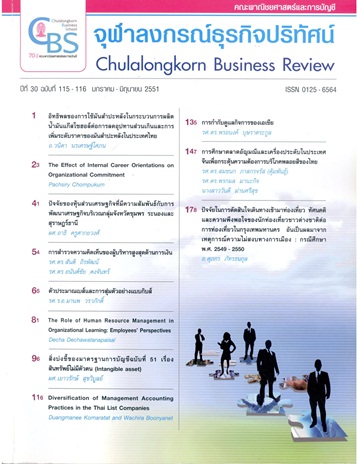สิ่งบ่งชี้ของมาตรฐานการบัญชีฉบับที่ 51 เรื่อง สินทรัพย์ไม่มีตัวตน
Main Article Content
Abstract
บทคัดย่อ
สินทรัพย์ไม่มีตัวตน อาจจัดประเภทเป็นสินทรัพย์ไม่มีตัวตนที่สามารถระบุได้ เช่น สิทธิบัตร ลิขสิทธิ์ และเครื่องหมายการค้า หรือสินทรัพย์ไม่มีตัวตนที่ไม่สามารถระบุได้ เช่น ค่าความนิยม ซึ่งสินทรัพย์ไม่มีตัวตนที่มีอายุการให้ประโยชน์แน่นอน ให้ตัดจำหน่ายตามอายุการใช้งานและประเมินการด้อยค่า โดยเริ่มตัดจำหน่ายเมื่อสินทรัพย์นั้นพร้อมจะให้ประโยชน์ได้ ตลอดอายุการให้ประโยชน์ และต้องใช้วิธีเส้นตรงในการตัดจำหน่าย หากไม่สามารถกำหนดรูปแบบได้อย่างน่าเชื่อถือ และต้องทบทวนวิธีและระยะเวลาการตัดจำหน่ายทุกงวดปีบัญชีเป็นอย่างน้อย ส่วนสินทรัพย์ไม่มีตัวตนที่ไม่มีอายุการให้ประโยชน์แน่นอน ไม่ต้องตัดจำหน่าย แต่ต้องประเมินการด้อยค่า มาตรฐานการบัญชี ฉบับที่ 51 กำหนดให้กิจการต้องวัดมูลค่าสินทรัพย์ไม่มีตัวตนเมื่อเริ่มแรกด้วยราคาทุน แต่ถ้าผู้ซื้อไม่สามารถวัดมูลค่าราคาทุน (มูลค่ายุติธรรม) ของสินทรัพย์ไม่มีตัวตนที่ได้มาจากการรวมธุรกิจที่เป็นการซื้อได้อย่างน่าเชื่อถือ หรือไม่เป็นไปตามคำนิยามและเกณฑ์การรับรู้ของสินทรัพย์ไม่มีตัวตน ผู้ซื้อต้องไม่รับรู้สินทรัพย์นั้นเป็นสินทรัพย์ไม่มีตัวตนแยกต่างหาก ให้บันทึกรวมไว้กับค่าความนิยม สำหรับสินทรัพย์ไม่มีตัวตนที่เกิดขึ้นภายในให้แบ่งออกเป็นขั้นตอนการวิจัยซึ่งต้องบันทึกเป็นค่าใช้จ่าย และขั้นตอนการพัฒนาให้บันทึกเป็นสินทรัพย์ไม่มีตัวตน เมื่อมีความเป็นไปได้ทางเทคนิคที่จะทำให้สินทรัพย์ไม่มีตัวตนเสร็จสมบูรณ์ เพื่อนำมาใช้ประโยชน์ หรือนำมาขาย หากกิจการไม่สามารถแยกขั้นตอนดังกล่าวออกจากกันได้ กิจการต้องถือว่ารายจ่ายของโครงการภายในที่ก่อให้เกิดสินทรัพย์ไม่มีตัวตน เป็นรายจ่ายที่เกิดขึ้นในขั้นตอนการวิจัยเท่านั้น ส่วนการวัดมูลค่าภายหลังการรับรู้เมื่อเริ่มแรก กิจการสามารถเลือกใช้วิธีราคาทุน หรือวิธีตีราคาใหม่ในการแสดงมูลค่าสินทรัพย์ไม่มีตัวตนได้ตามที่มาตรฐานการบัญชีฉบับนี้กำหนดไว้
Abstract
Intangible Assets are classified as Identifiable Intangible Assets such as Patents, Copyrights, Trademarks or Unidentifiable Intangible Assets such as Goodwill. An intangible asset with a definite useful life should be amortised over that life. The amortisation method should reflect the pattern of benefits. If the pattern cannot be determined reliably, amortise by the straight line method. The amortisation period should be reviewed at least annually. An intangible asset with an indefinite useful life should not be amortised. The asset should also be assessed for impairment. TAS 51 requires an enterprise to recognise an intangible asset at cost. An expenditure (included in the cost of acquisition) on an intangible item that does not meet both the definition of and recognition criteria for an intangible asset should form part of the amount attributed to the goodwill recognised at the acquisition date. All research costs must be charged to expense. Development costs are capitalised only after technical and commercial feasibility of the asset for sale or use have been established. If an enterprise cannot distinguish the research phase of an internal project to create an intangible asset from the development phase, the enterprise treats the expenditure for that project as if it were incurred in the research phase only. Intangible assets are initially measured at cost. After initial recognition an entity must choose either the cost model or the revaluation model for each class of intangible asset.
Article Details
Opinions and discussions in papers published by the Creative Business and Sustainability Journal (CBSJ) are deemed as personal opinions and the responsibility of the writers. They are not the opinions or responsibility of the Chulalongkorn Business School of Chulalongkorn University.
Papers, content, information etc. appearing in the Journal are deemed to be the copyright property of the Chulalongkorn Business School of Chulalongkorn University. Anybody or any organization that wishes to publish any part of them or use them in any way must obtain written permission from the Chulalongkorn Business School, Chulalongkorn University.


